
Robert I, popularly known as Robert the Bruce, was King of Scots from 1306 to his death in 1329. One of the most renowned warriors of his generation, Robert eventually led Scotland during the First War of Scottish Independence against England. He fought successfully during his reign to regain Scotland's place as an independent kingdom and is now revered in Scotland as a national hero.

The Wars of Scottish Independence were a series of military campaigns fought between the Kingdom of Scotland and the Kingdom of England in the late 13th and early 14th centuries.

John Balliol, known derisively as Toom Tabard, was King of Scots from 1292 to 1296. Little is known of his early life. After the death of Margaret, Maid of Norway, Scotland entered an interregnum during which several competitors for the Crown of Scotland put forward claims. Balliol was chosen from among them as the new King of Scotland by a group of selected noblemen headed by King Edward I of England.
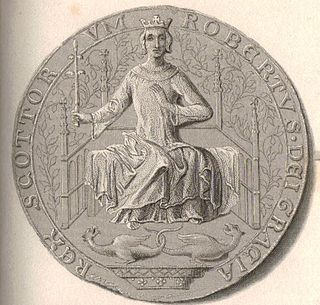
Robert II was King of Scots from 1371 to his death in 1390. The son of Walter Stewart, 6th High Steward of Scotland, and Marjorie, daughter of King Robert the Bruce, he was the first monarch of the House of Stewart. Upon the death of his uncle David II, Robert succeeded to the throne.
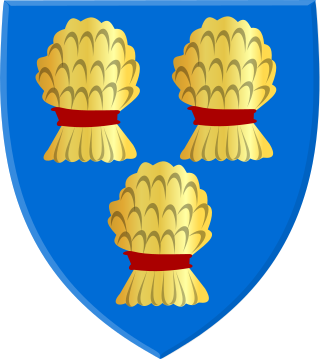
John Comyn III of Badenoch, nicknamed the Red, was a leading Scottish baron and magnate who played an important role in the First War of Scottish Independence. He served as Guardian of Scotland after the forced abdication of his uncle, King John Balliol, in 1296, and for a time commanded the defence of Scotland against English attacks. Comyn was stabbed to death by Robert the Bruce before the altar at the church of the Greyfriars at Dumfries.
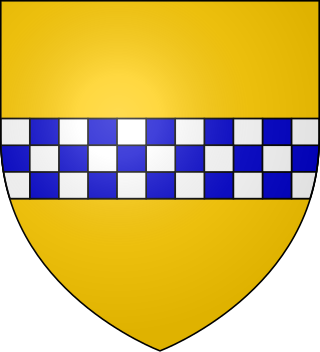
James Stewart was the 5th Hereditary High Steward of Scotland and a Guardian of Scotland during the First Interregnum.

Clan Bruce is a Lowlands Scottish clan. It was a royal house in the 14th century, producing two kings of Scotland, and a disputed High King of Ireland, Edward Bruce.
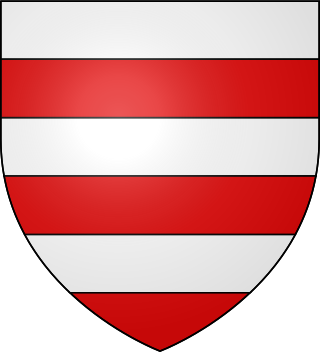
William II de Soules, Lord of Liddesdale and Butler of Scotland, was a Scottish Border noble during the Wars of Scottish Independence. William was the elder son of Nicholas II de Soules, Lord of Liddesdale and Butler of Scotland, and a cousin of Alexander Comyn, Earl of Buchan. He was the nephew of John de Soules, Guardian of Scotland.

William de Lamberton, sometimes modernized as William Lamberton, was Bishop of St Andrews from 1297 until his death. Lamberton is renowned for his influential role during the Scottish Wars of Independence. He campaigned for the national cause under William Wallace and later Robert the Bruce. As Bishop of St Andrews, the most powerful seat in Scotland, Bishop Lamberton along with Bishop Robert Wishart of Glasgow conducted the coronation of Robert the Bruce as King Robert I. Lamberton would go on to have a vital role in the formulation of the Declaration of the Clergy 1310 and the Declaration of Arbroath which would lead to Scottish Independence.
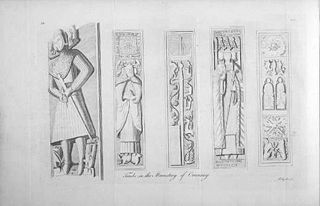
John of Islay was the Lord of the Isles (1336–1386) and chief of Clan Donald. In 1336, he styled himself Dominus Insularum, "Lord of the Isles"; although this was not the first ever recorded instance of the title in use. Some modern historians nevertheless count John as the first of the later medieval Lords of the Isles, although this rather broad Latin style corresponds roughly with the older Gaelic title Rí Innse Gall, in use since the Viking Age. For instance, the even more similar Latin title dominus de Inchegal, applied to Raghnall Mac Somhairle in the mid-12th century. In fact John is actually styled Rí Innsi Gall or King of the Isles shortly after his death in a contemporary entry in the Irish Annals of Ulster. Clan Donald considers the title "Lord of the Isles" to have been in use at least since Angus Mor Macdonald, who died in 1293. and the title "King of the Isles" in use since Somerled, the Norse-Gael who forged the Kingdom of the Isles in the 12th century.

Sir Ingram de Umfraville was a Scottish noble who played a particularly chequered role in the Wars of Scottish Independence, changing sides between England and Scotland multiple times, throughout the conflict.
Christian or Christina Bruce, also known as Christian or Christina de Brus, was a daughter of Marjorie, Countess of Carrick, and her husband, Robert de Brus, jure uxoris Earl of Carrick, as well as a sister of Robert the Bruce, King of Scots. It is presumed that she and her siblings were born at Turnberry Castle in Carrick.

John of Argyll, was a Scottish nobleman of the early 14th century. He is often known to today as John Bacach, "the Lame", but there is no authority for that as a contemporary or near-contemporary nickname.

Sir David de Brechin was a Scottish knight who fought on both sides during the Wars of Scottish Independence.
Alexander de Abernethy was a Scottish baron. He was a son of Hugh de Abernethy and Maria de Ergadia. Alexander was a descendant of abbots of Abernethy; his great-grandfather Laurence, great-grandson of Gillemichael, Earl of Fife, was the first to style himself Lord (dominus) His daughter Margaret married John Stewart of Bonkyll, the new Scottish earl of Angus.

Sir Alexander Lindsay, Lord of Barnweill, Byres and Crawford, also known as Alexander de Lindsay, was a Scottish noble.

John de Moels, 1st Baron Moels, feudal baron of North Cadbury in Somerset, was an English peer.
Nicholas de Soules, Lord of Liddesdale and Butler of Scotland, was a 13th-century Scottish Border noble.
John Lindsay, Lord of Wauchope and Staplegorton, was a Scottish noble.

John Lovel, Lord of Minster Lovel and Titchmarsh, was an English noble.
















